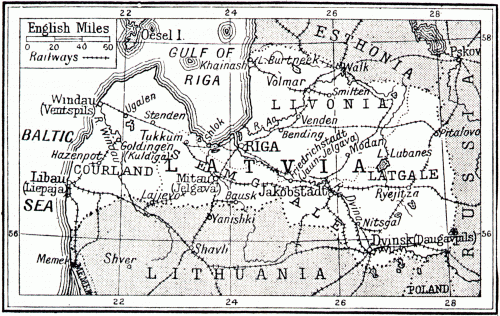| C |
ONSEQUENT on the Great War, numerous changes impressed themselves on the countries and civilizations of Europe—in particular, alterations of government, as well as of boundaries. From beneath the wreckage of overthrown States new ones have sprung into being ; old wrongs have been righted, and ancient peoples have found themselves re-established within their own national borders.
Among the States born to the thunder of cannon are the Baltic States, which formerly lay within Russian territory and now hold a specially significant position in modern Europe. One of these newly-founded sovereign States, bordering on the Baltic Sea, is Latvia, the country of the Letts. The Letts, with their neighbours, the Lithuanians, on the south, belong to a branch of the Indo-European parent people, from which all peoples of the white race, except perhaps the Semites, trace their origin, and appear to be entirely distinct from the Slavonic and Germanic branches. It is claimed for them that they have inhabited these lands for no fewer than five thousand years, and their legendary history would certainly cover that period of time.
Such history must, of course, be regarded as more or less conjectural; and we are on firmer ground when we take account of the testimony given by Greek and Roman writers, such as Ptolemy, Herodotus, Tacitus, and Pliny, all of whom have something to say respecting the manners and occupations of the Baltic tribes. These records at the least put it beyond doubt that the Letts, together with the Lithuanians and the ancient Prussians, inhabited the Baltic regions in remote antiquity.
In Lettish folklore, Latvia has frequently been designated the "Amber Land," and it is not unlikely that the ancient Letts were first to discover the amber deposits on the Baltic seaboard. It was with ancient Latvia, three thousand years ago, that the Phoenician merchants, always on the look-out for opportunities by which to promote the commercial interests of their country, carried on a profitable trade in amber. Roman and Greek coins, the latter from the time of Alexander the Great, have been found in Latvia in considerable numbers; while amber ornaments of the reddish variety of succinite, met with in abundance in Courland, have been discovered in the Mycenaean tombs; in which tombs there were also found specimens of dainty golden ornaments similar to those unearthed from Latvian mounds. These excavations of fairly recent years substantiate the early intercourse between Latvia and southern
| 1 | These numbers indicate original page breaks for anyone citing this work as a reference. |
 Gallery
Gallery
